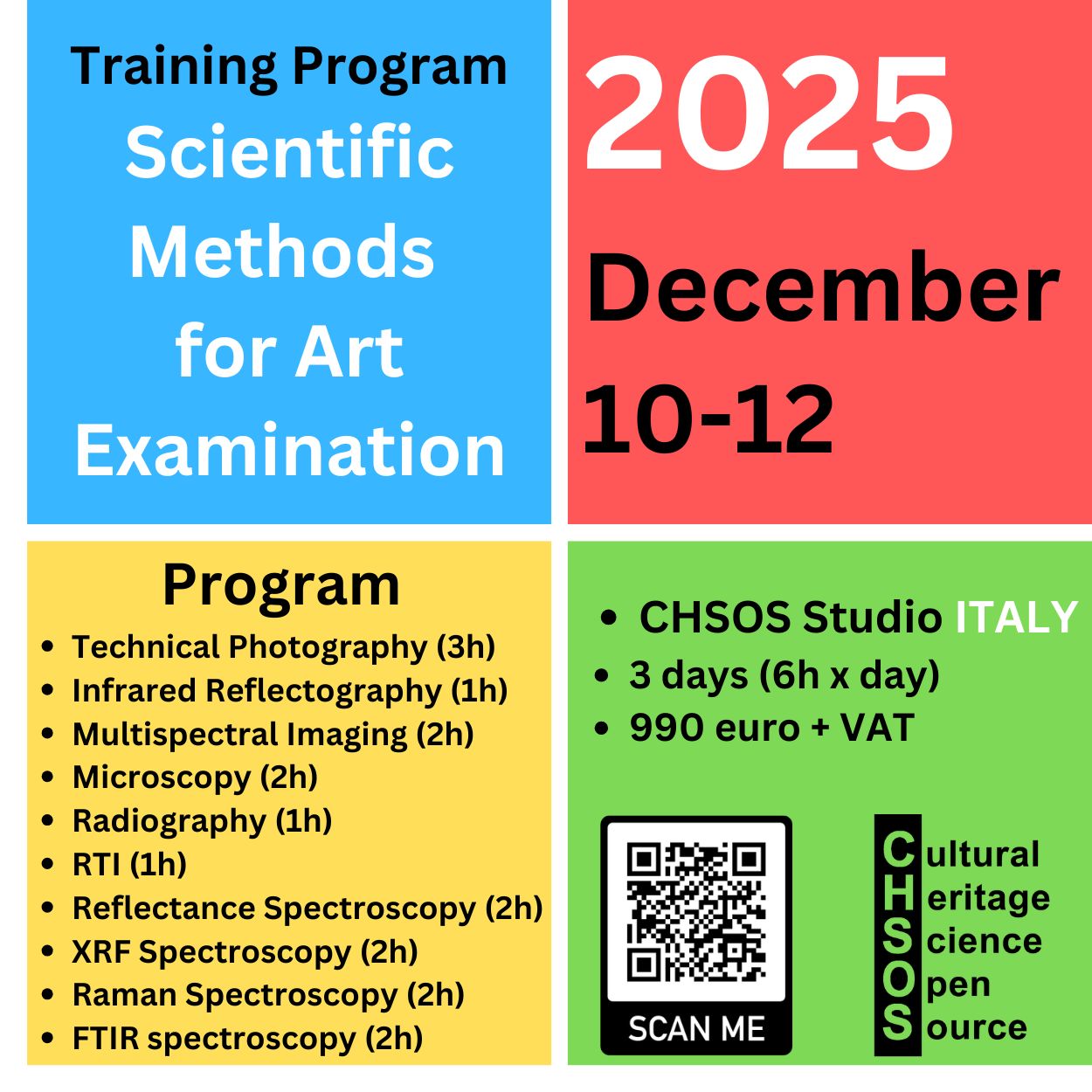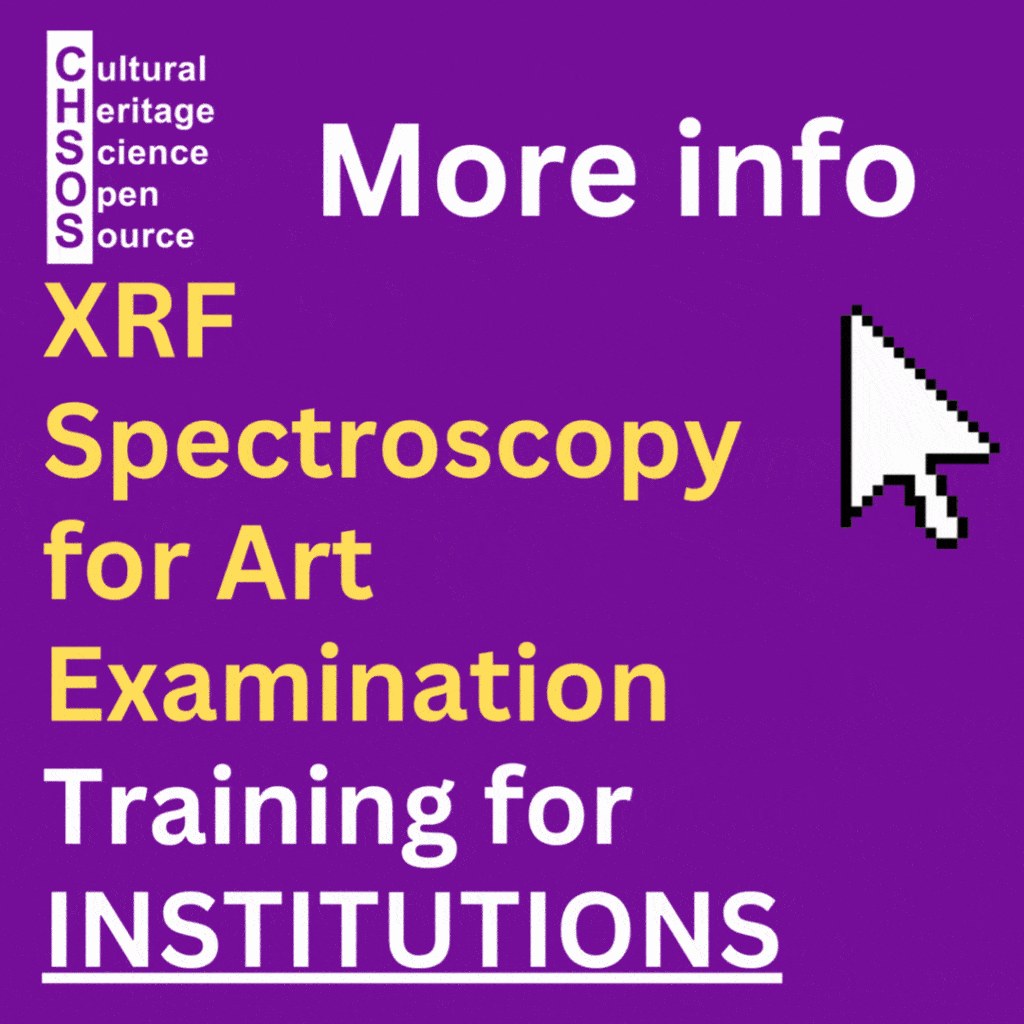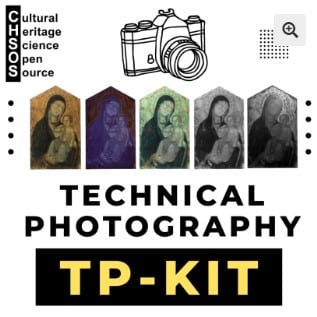Home » About » CHSOS Application Notes » CHSOS Application note #3: Transmitted Infrared Photography with SALVO
Transmitted Infrared Photography with SALVO
Transmitted Infrared photography (IRT) is a well-established technical photography method that makes pigments more transparent than the standard Infrared photography (IR).
This note illustrates this method, showing results from Pigments Checker to evaluate, for each pigment, how this approach is better than the standard infrared photo. Eventually, we present the imaging done on a manuscript with a later added drawing that conceals part of the writing.
Transmitte Infrared Photography in Technical Photography Examination
Technical Photography is usually performed in the reflection mode: the lamps (UV, VIS, and IR) are facing the object sitting on the same side of the camera. On the other hand, in the transmission mode, the object stands between the camera and the lamps. This approach can be implemented for all the 3 spectral ranges, UV, VIS, and, IR and we indicate these images by adding a T to the reflection mode acronyms. So, we have VIST, UVT, and IRT.
So far, IRT has proven the most successful and extensively studied of the transmission modes.
IRT is part of the Technical Photography documentation and allows the detection of underdrawing and pentimenti [1, 2]. It is a very effective imaging method since pigments become even more transparent than in the usual IR photography method.
Applications
This approach is useful only for objects with translucent supports, such as paintings on canvas, and works on paper and historical documents. The IR lamp should face the back of the object while the camera looks at the front. The lamp should be shielded so that only the radiation through the support can reach the camera.
Turn off any other IR sources in the room to prevent diffused infrared from bouncing onto the object. In some cases, it may be useful to test the method by changing the setup and positioning the camera to face the back of the object. However, the original configuration is generally preferred because it produces sharper drawing lines, as the infrared light doesn’t get diffused by the canvas.
Equipment
Figure [1] shows some of the equipment used to prepare the imaging presented in this note and this is the complete list:
• Nikon D800 camera modified full spectrum
• ROBERTINA Technical Photo filter
• ELIO halogen lamps
• SALVO UV-VIS-IR Imaging Panel
• Pigments Checker

Pigments Checker
Our Pigments Checker collection features historical pigments ranging from antiquity to the early 1950s. We apply the colors with an acrylic binder on a cardboard support. Pigments Checker includes a translucent backing, similar to that of a canvas painting or a work on paper. This design allows us to use it for practicing effective imaging methods involving transmitted radiation, such as IRT.
Transmitted Infrared Photography on the white pigments
IRT is so powerful, in particular for white pigments, such as lead white and titanium white, the most common in art, respectively, before and after the 1920s. These pigments reflect a lot of the incoming infrared and, consequently, their hiding power is barely affected by the infrared coming from the front. They will just reflect most of the IR, and they will not produce contrast between the ground and the underdrawing. This means they remain mostly opaque.
When the infrared radiation comes from the back (transmission mode), the infrared can penetrate the paint, and the underdrawing becomes apparent in the resulting IRT image.
Figure [2] shows Pigments Checker as we positioned it on the SALVO Imaging Panel for this test.
Figure [3] illustrates the results for some of the white pigments. The advantage of the IRT method is unmistakable. Crossed lines that were drawn on the bare cardboard are now clearly evident as if the white paint was not there. The same happens for many of the other pigments. Figure [4] illustrates two other examples.



Case study: item #17
From the CHSOS Educational Collection, we selected item #17—a peculiar manuscript that combines different styles, which complicates its regional and historical classification. Notably, this manuscript features an illustration layered over the writing, making it an ideal case for IRT photography. As shown in Figure [5], the item sits on the SALVO Imaging Panel, ready for imaging. Furthermore, Figure [6] presents close-up views of the VIS and IRT photographs. In the IRT image, the white, yellow, blue, and red pigments become transparent, revealing the writing hidden beneath them.


Conclusions
Infrared transmitted photography is a well-established method for analyzing works of art and historical documents on translucent supports, such as paper and canvas. With this in mind, the SALVO Imaging Panel simplifies the process by allowing users to switch easily among the three spectral regions: UV, VIS, and IR. As a result, you can capture all images without moving the object, ensuring precise registration and overlap. Moreover, there’s no need to replace lamps or reposition the setup, since the panel lets you activate different LEDs remotely, using a simple remote control.
References
- A. Cosentino “Transmittance spectroscopy and transmitted multispectral imaging to map covered paints” Conservar Património 24, 37-45, 2016.
- A. Cosentino “Infrared Technical Photography for Art Examination” e-Preservation Science, 13, 1-6, 2016.
Resources
National Gallery (London)
The National Gallery has pioneered the use of infrared imaging to study underdrawings in paintings. For example, the gallery’s infrared imaging study of Raphael’s Madonna of the Pinks (~1506–07), revealing an exquisite underdrawing beneath the paint layers.






